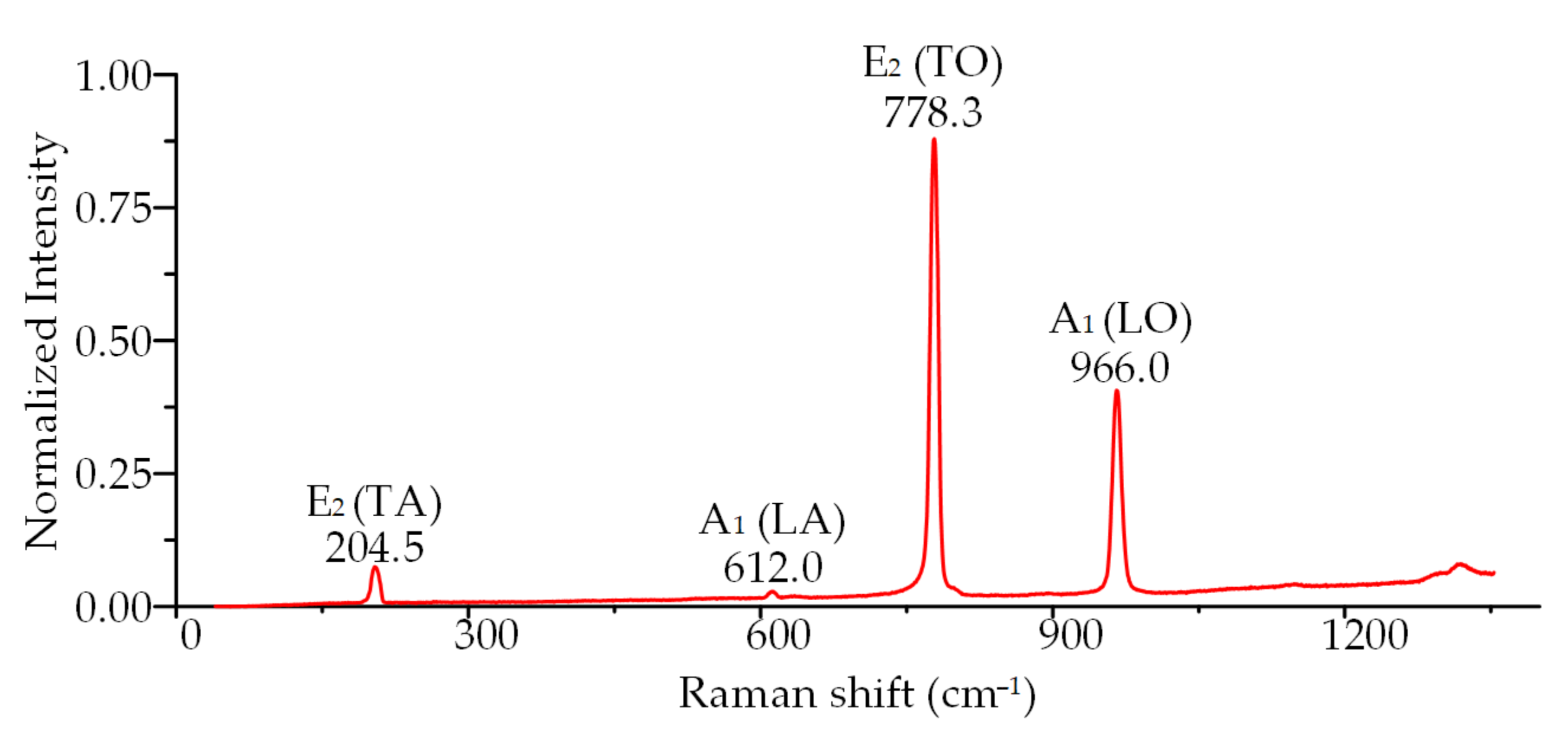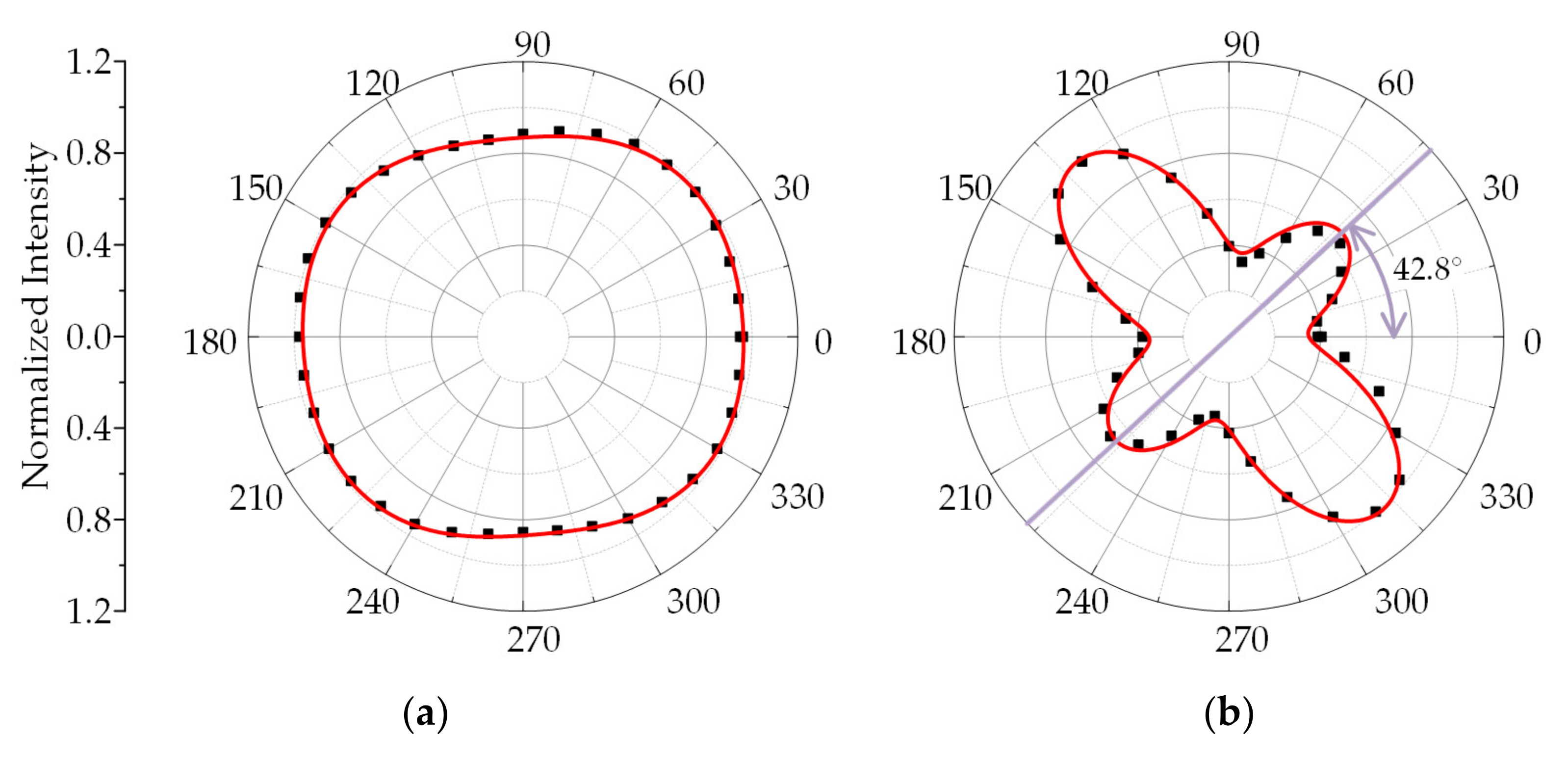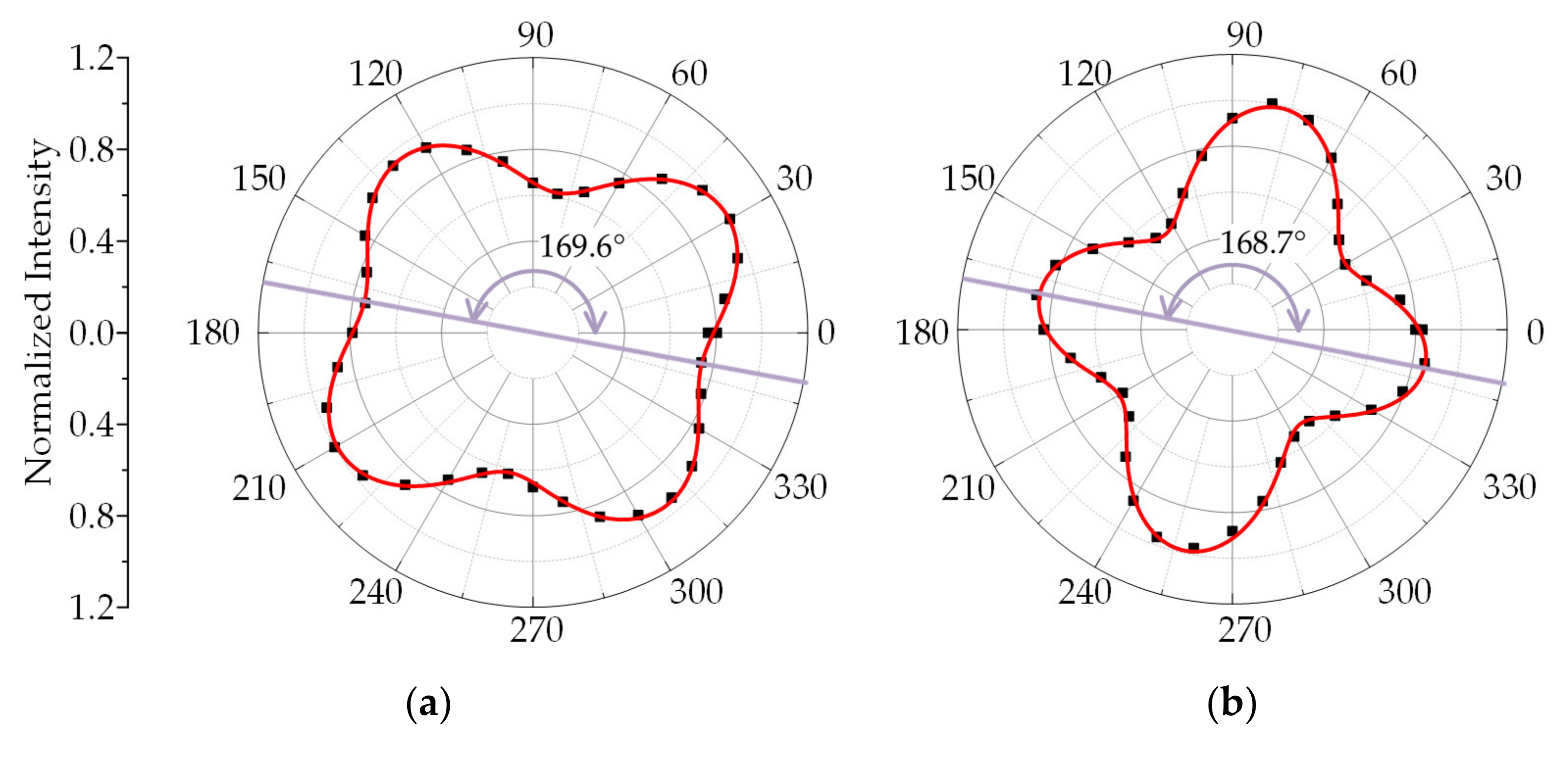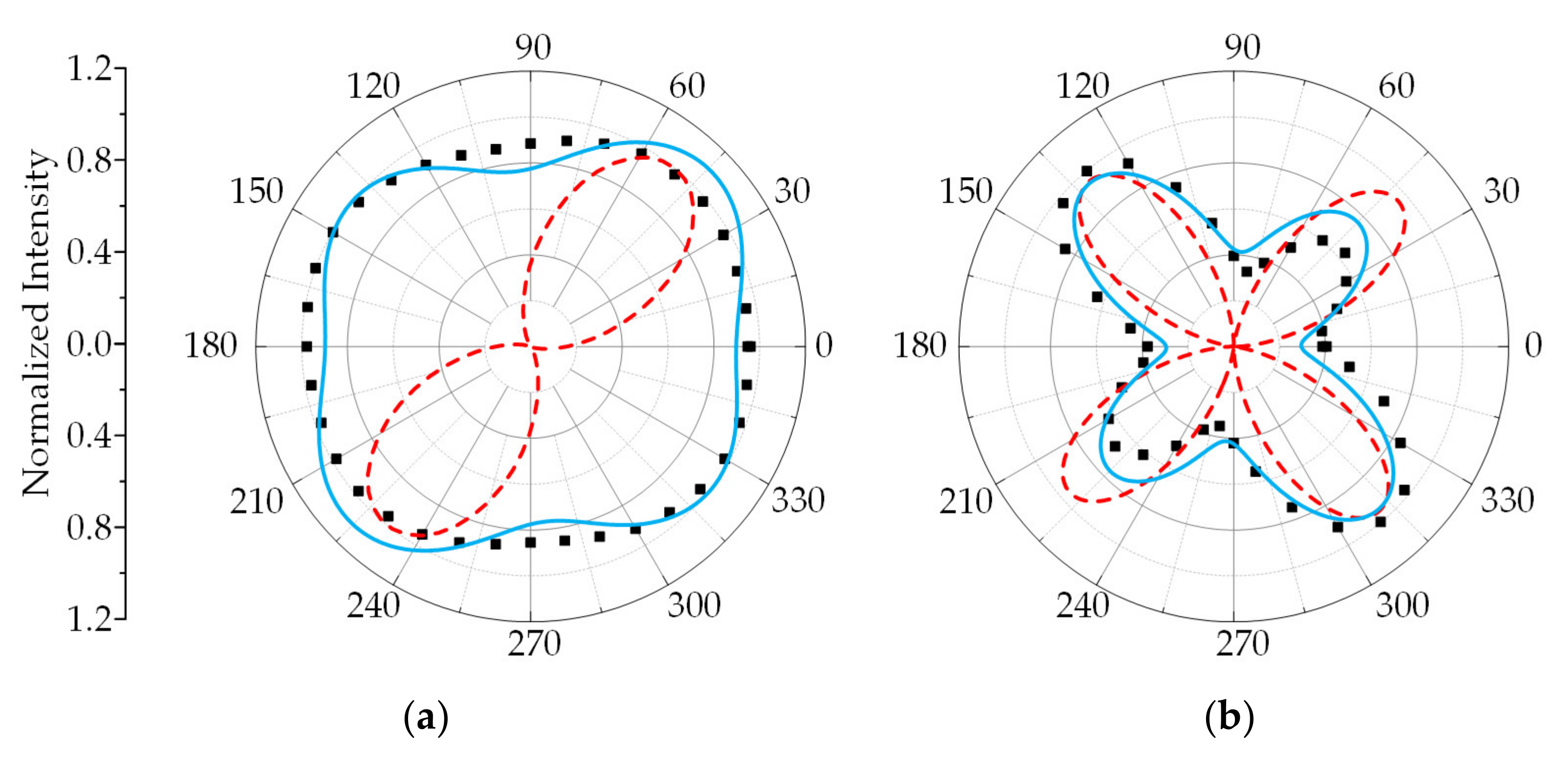Angle-Resolved Intensity of Polarized Micro-Raman Spectroscopy for 4H-SiC
Abstract
1. Introduction
2. Materials and Experiments
3. Method and Results
3.1. Raman Spectra of SiC
3.2. Raman Intensity Theory of SiC
3.3. Analysis of Raman Intensity of SiC
3.3.1. Vertical Backscattering
- HH case
- HV case
3.3.2. Oblique Backscattering ii = is = i > 0°
- HH case
- HV case
4. Discussion
5. Conclusions
Author Contributions
Funding
Data Availability Statement
Conflicts of Interest
Appendix A
References
- Guo, J.; Yang, Y.; Raghothamachar, B.; Kim, T.; Dudley, M.; Kim, J. Understanding the microstructures of triangular defects in 4H-SiC homoepitaxial. J. Cryst. Growth 2017, 480, 119–125. [Google Scholar] [CrossRef]
- Ramsdell, L.S. Studies on silicon carbide. Am. Mineral. 1947, 32, 64–82. [Google Scholar]
- Schaffer, W.J.; Negley, G.H.; Irvine, K.G.; Palmour, J.W. Conductivity Anisotropy in Epitaxial 6H and 4H Sic. MRS Online Proc. Libr. Arch. 1994, 339, 595. [Google Scholar] [CrossRef]
- Lyon, L.A.; Keating, C.D.; Fox, A.P.; Baker, B.E.; Natan, M.J. Raman Spectroscopy. Anal. Chem. 1998, 70, 341–361. [Google Scholar] [CrossRef] [PubMed]
- Nafie, L.A. Recent advances in linear and non-linear Raman spectroscopy. Part XI. J. Raman Spectrosc. 2017, 48, 1692–1717. [Google Scholar] [CrossRef]
- Qiu, W.; Kang, Y.L. Mechanical behavior study of microdevice and nanomaterials by Raman spectroscopy: A review. Chin. Sci. Bull. 2014, 59, 2811–2824. [Google Scholar] [CrossRef]
- Li, R.B.; Shang, Y.C.; Xing, H.D.; Wang, X.J.; Sun, M.Y.; Qiu, W. Orientation Identification of the Black Phosphorus with Different Thickness Based on B-2g Mode Using a Micro-Raman Spectroscope under a Nonanalyzer Configuration. Materials 2020, 13, 5572. [Google Scholar] [CrossRef] [PubMed]
- Gudaitis, R.; Lazauskas, A.; Jankauskas, S.; Meskinis, S. Catalyst-Less and Transfer-Less Synthesis of Graphene on Si (100) Using Direct Microwave Plasma Enhanced Chemical Vapor Deposition and Protective Enclosures. Materials 2020, 13, 5630. [Google Scholar] [CrossRef]
- Yin, J.H.; Zhou, B.D.; Li, L.; Liu, Y.; Guo, W.; Talwar, D.N.; He, K.Y.; Ferguson, I.T.; Wan, L.Y.; Feng, Z.C. Optical and structural properties of AlN thin films deposited on different faces of sapphire substrates. Semicond. Sci. Tech. 2021, 36, 045012. [Google Scholar] [CrossRef]
- Fu, D.H.; He, X.Y.; Ma, L.L.; Xing, H.D.; Meng, T.; Chang, Y.; Qiu, W. The 2-axis stress component decoupling of {100} c-Si by using oblique backscattering micro-Raman spectroscopy. Sci. China Phys. Mech. 2020, 63, 55–61. [Google Scholar] [CrossRef]
- Sun, C.L.; Wang, Y.J.; Gu, H.; Fan, H.B.; Yang, G.J.; Ignaszak, A.; Tang, X.F.; Liu, D.; Zhang, J.J. Interfacial coupled design of epitaxial Graphene@SiC Schottky junction with built-in electric field for high-performance anodes of lithium ion batteries. Nano Energy 2020, 77, 105092. [Google Scholar] [CrossRef]
- Matsumoto, M.; Huang, H.; Harada, H.; Kakimoto, K.; Yan, J. On the phase transformation of single-crystal 4H–SiC during nanoindentation. J. Phys. D Appl. Phys. 2017, 50, 265303. [Google Scholar] [CrossRef]
- Kim, H.K.; Kim, S.I.; Kim, S.; Lee, N.S.; Shin, H.K.; Lee, C.W. Relation between work function and structural properties of triangular defects in 4H-SiC epitaxial layer: Kelvin probe force microscopic and spectroscopic analyses. Nanoscale 2020, 12, 8216–8229. [Google Scholar] [CrossRef] [PubMed]
- Calabretta, C.; Agati, M.; Zimbone, M.; Boninelli, S.; Castiello, A.; Pecora, A.; Fortunato, G.; Calcagno, L.; Torrisi, L.; La Via, F. Laser Annealing of P and Al Implanted 4H-SiC Epitaxial Layers. Materials 2019, 12, 3362. [Google Scholar] [CrossRef] [PubMed]
- Uchimaru, T.; Ohmori, N.; Abe, Y.; Komiyama, J. Evaluation of Stacking Faults in Single-Crystalline 3C-SiC Films by Polarized Raman Spectroscopy. Jpn. J. Appl. Phys. 2013, 52, 075501. [Google Scholar] [CrossRef]
- Shen, W.M.; Shao, Z.X. Dispersion between Ordinary Ray and Extraordinary Ray in Uniaxial Crystals for Any Orientation of Optical Axis. Acta Opt. Sin. 2002, 6, 765–768. [Google Scholar]
- Simon, M.C. Ray tracing formulas for monoaxial optical components. Appl. Opt. 1983, 22, 354–360. [Google Scholar] [CrossRef]
- Sun, G.; Jin, S.L. Analyses of Jones Matrix of Birefringent Grystals. Appl. Opt. 2005, 26, 17–21. [Google Scholar]
- Qiu, W.; Ma, L.L.; Qiu, L.; Xing, H.D.; Cheng, C.L.; Huang, G.Y. A general metrology of stress on crystalline silicon with random crystal plane by using micro-Raman spectroscopy. Acta Mech. Sin. 2018, 34, 1095–1107. [Google Scholar] [CrossRef]
- Zhu, W.L.; Pezzotti, G. Raman analysis of three-dimensionally graded stress tensor components in sapphire. Appl. Phys. 2011, 109, 073502. [Google Scholar] [CrossRef]
- Zhao, D.S.; Wang, F.Z.; Wan, L.Y.; Yang, F.Y.; Feng, Z.C. Study on Anisotropic Properties of 4H-SiC by Polarized Raman Scattering Spectroscopy. Light Scatt. 2018, 30, 133–138. [Google Scholar]
- Wang, S.; Zhan, M.; Wang, G.; Xuan, H.; Zhang, W.; Liu, C.; Xu, C.; Liu, Y.; Wei, Z.; Chen, X. 4H-SiC: A new nonlinear material for midinfrared lasers. Laser Photonics Rev. 2013, 7, 831–838. [Google Scholar] [CrossRef]
- Small Crystals, High Energy. Available online: http://www.ccdi.gov.cn/yaowen/202006/t20200608_219667.html (accessed on 6 April 2021).
- Xu, Z.W.; He, Z.D.; Song, Y.; Fu, X.; Rommel, M.; Luo, X.C.; Hartmaier, A.; Zhang, J.J.; Fang, F.Z. Topic Review: Application of Raman Spectroscopy Characterization in Micro/Nano-Machining. Micromachines 2018, 9, 361. [Google Scholar] [CrossRef] [PubMed]
- Sakakima, H.; Takamoto, S.; Murakami, Y.; Hatano, A.; Goryu, A.; Hirohata, K.; Izumi, S. Development of a method to evaluate the stress distribution in 4H-SiC power devices. Jpn. J. Appl. Phys. 2018, 57, 106602. [Google Scholar] [CrossRef]
- Suda, J.; Suwa, S.; Mizuno, S.; Togo, K.; Mastuo, Y. Micro-Raman imaging on 4H-SiC in contact with the electrode at room temperature. Spectrochim. Acta A 2018, 193, 393–396. [Google Scholar] [CrossRef] [PubMed]
- Wang, S. Opaque Mineral Crystal Optics, 2nd ed.; Geological Publishing House: Beijing, China, 1987; p. 88. [Google Scholar]








Publisher’s Note: MDPI stays neutral with regard to jurisdictional claims in published maps and institutional affiliations. |
© 2021 by the authors. Licensee MDPI, Basel, Switzerland. This article is an open access article distributed under the terms and conditions of the Creative Commons Attribution (CC BY) license (https://creativecommons.org/licenses/by/4.0/).
Share and Cite
Chang, Y.; Xiao, A.; Li, R.; Wang, M.; He, S.; Sun, M.; Wang, L.; Qu, C.; Qiu, W. Angle-Resolved Intensity of Polarized Micro-Raman Spectroscopy for 4H-SiC. Crystals 2021, 11, 626. https://doi.org/10.3390/cryst11060626
Chang Y, Xiao A, Li R, Wang M, He S, Sun M, Wang L, Qu C, Qiu W. Angle-Resolved Intensity of Polarized Micro-Raman Spectroscopy for 4H-SiC. Crystals. 2021; 11(6):626. https://doi.org/10.3390/cryst11060626
Chicago/Turabian StyleChang, Ying, Aixia Xiao, Rubing Li, Miaojing Wang, Saisai He, Mingyuan Sun, Lizhong Wang, Chuanyong Qu, and Wei Qiu. 2021. "Angle-Resolved Intensity of Polarized Micro-Raman Spectroscopy for 4H-SiC" Crystals 11, no. 6: 626. https://doi.org/10.3390/cryst11060626
APA StyleChang, Y., Xiao, A., Li, R., Wang, M., He, S., Sun, M., Wang, L., Qu, C., & Qiu, W. (2021). Angle-Resolved Intensity of Polarized Micro-Raman Spectroscopy for 4H-SiC. Crystals, 11(6), 626. https://doi.org/10.3390/cryst11060626







